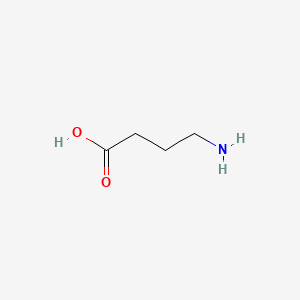| MeSH term | MeSH ID | Detail |
|---|---|---|
| Hepatic Encephalopathy | D006501 | 9 associated lipids |
| Hypothyroidism | D007037 | 32 associated lipids |
| Substance Withdrawal Syndrome | D013375 | 9 associated lipids |
| Leukemia, Erythroblastic, Acute | D004915 | 41 associated lipids |
| Pain, Postoperative | D010149 | 13 associated lipids |
| Occupational Diseases | D009784 | 42 associated lipids |
| Kidney Diseases | D007674 | 29 associated lipids |
| Weight Gain | D015430 | 101 associated lipids |
| Hyperemia | D006940 | 25 associated lipids |
| Brain Diseases | D001927 | 27 associated lipids |
4-aminobutyric acid
4-aminobutyric acid is a lipid of Fatty Acyls (FA) class. 4-aminobutyric acid is associated with abnormalities such as Epilepsy and Premenstrual syndrome. The involved functions are known as Binding (Molecular Function), neuron survival, Process, Uptake and physiological aspects. 4-aminobutyric acid often locates in Microglial, Neurofilament, Neuraxis, Brain region and Neurites. The associated genes with 4-aminobutyric acid are arginine methyl ester, SLC33A1 gene, NKS1 gene, P4HTM gene and ITSN2 gene. The related lipids are pregnenolone sulfate, pregnane-20-one, Pregnanes, Steroids and endogenous steroids.
Cross Reference
Introduction
To understand associated biological information of 4-aminobutyric acid, we collected biological information of abnormalities, associated pathways, cellular/molecular locations, biological functions, related genes/proteins, lipids and common seen animal/experimental models with organized paragraphs from literatures.
What diseases are associated with 4-aminobutyric acid?
4-aminobutyric acid is suspected in Premenstrual syndrome, Epilepsy and other diseases in descending order of the highest number of associated sentences.
Related references are mostly published in these journals:
| Disease | Cross reference | Weighted score | Related literature |
|---|
Possible diseases from mapped MeSH terms on references
We collected disease MeSH terms mapped to the references associated with 4-aminobutyric acid
PubChem Associated disorders and diseases
What pathways are associated with 4-aminobutyric acid
There are no associated biomedical information in the current reference collection.
PubChem Biomolecular Interactions and Pathways
Link to PubChem Biomolecular Interactions and PathwaysWhat cellular locations are associated with 4-aminobutyric acid?
Visualization in cellular structure
Associated locations are in red color. Not associated locations are in black.
Related references are published most in these journals:
| Location | Cross reference | Weighted score | Related literatures |
|---|
What functions are associated with 4-aminobutyric acid?
Related references are published most in these journals:
| Function | Cross reference | Weighted score | Related literatures |
|---|
What lipids are associated with 4-aminobutyric acid?
Related references are published most in these journals:
| Lipid concept | Cross reference | Weighted score | Related literatures |
|---|
What genes are associated with 4-aminobutyric acid?
Related references are published most in these journals:
| Gene | Cross reference | Weighted score | Related literatures |
|---|
What common seen animal models are associated with 4-aminobutyric acid?
There are no associated biomedical information in the current reference collection.
NCBI Entrez Crosslinks
All references with 4-aminobutyric acid
Download all related citations| Authors | Title | Published | Journal | PubMed Link |
|---|---|---|---|---|
| Scharfman HE and MacLusky NJ | Differential regulation of BDNF, synaptic plasticity and sprouting in the hippocampal mossy fiber pathway of male and female rats. | 2014 | Neuropharmacology | pmid:23660230 |
| Zhu Y et al. | Activity-dependent hyperpolarization of EGABA is absent in cutaneous DRG neurons from inflamed rats. | 2014 | Neuroscience | pmid:24135545 |
| Vashchinkina E et al. | Neurosteroid Agonist at GABAA receptor induces persistent neuroplasticity in VTA dopamine neurons. | 2014 | Neuropsychopharmacology | pmid:24077066 |
| Mango D et al. | Phosphodiesterase 10A controls D1-mediated facilitation of GABA release from striato-nigral projections under normal and dopamine-depleted conditions. | 2014 | Neuropharmacology | pmid:23973317 |
| Chukwu J et al. | Weight change, genetics and antiepileptic drugs. | 2014 | Expert Rev Clin Pharmacol | pmid:24308788 |
| Dambach H et al. | Glia and epilepsy: experimental investigation of antiepileptic drugs in an astroglia/microglia co-culture model of inflammation. | 2014 | Epilepsia | pmid:24299259 |
| Chou HT et al. | Functional characterization of the agtABCD and agtSR operons for 4-aminobutyrate and 5-aminovalerate uptake and regulation in Pseudomonas aeruginosa PAO1. | 2014 | Curr. Microbiol. | pmid:23982201 |
| Sancheti H et al. | Reversal of metabolic deficits by lipoic acid in a triple transgenic mouse model of Alzheimer's disease: a 13C NMR study. | 2014 | J. Cereb. Blood Flow Metab. | pmid:24220168 |
| Di Giorgio NP et al. | Impaired GABAB receptor signaling dramatically up-regulates Kiss1 expression selectively in nonhypothalamic brain regions of adult but not prepubertal mice. | 2014 | Endocrinology | pmid:24424047 |
| Vanelderen P et al. | Effects of chronic administration of amitriptyline, gabapentin and minocycline on spinal brain-derived neurotrophic factor expression and neuropathic pain behavior in a rat chronic constriction injury model. | 2013 Mar-Apr | Reg Anesth Pain Med | pmid:23337936 |
